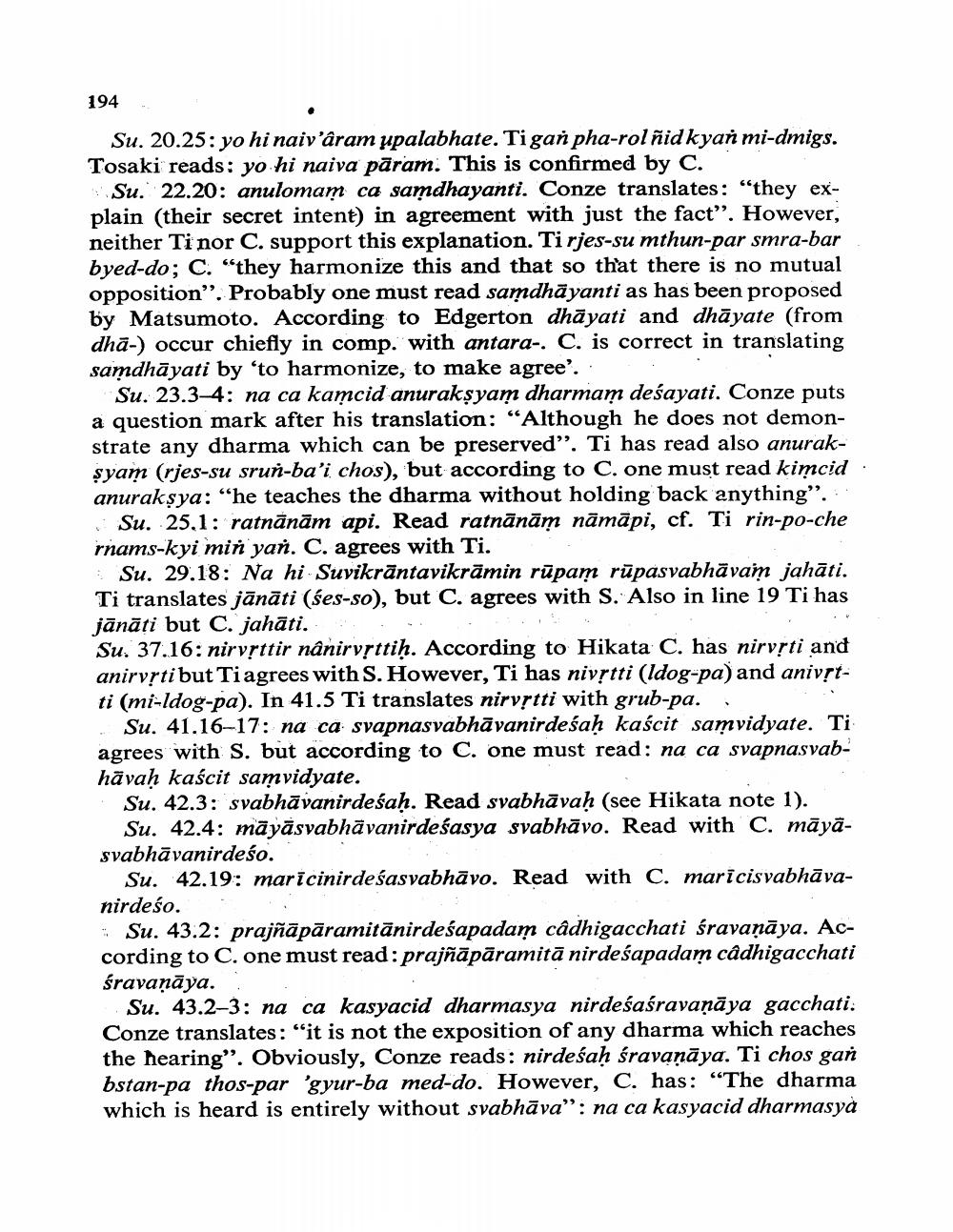Book Title: Notes On Prajnaparamita Texts Author(s): J W De Jong Publisher: J W De Jong View full book textPage 8
________________ 194 Su. 20.25: yo hi naiv'âram upalabhate. Tigan pha-rolñid kyan mi-dmigs. Tosaki reads: yo hi naiva pāram. This is confirmed by C. Su. 22.20: anulomam ca samdhayanti. Conze translates: “they explain their secret intent) in agreement with just the fact”. However, neither Ti nor C. support this explanation. Ti rjes-su mthun-par smra-bar byed-do; C. "they harmonize this and that so that there is no mutual opposition". Probably one must read samdhāyanti as has been proposed by Matsumoto. According to Edgerton dhāyati and dhāyate (from dhā-) occur chiefly in comp. with antara-. C. is correct in translating samdhāyati by 'to harmonize, to make agree'. - Su. 23.3-4: na ca kamcid anuraksyam dharmam deśayati. Conze puts a question mark after his translation: “Although he does not demonstrate any dharma which can be preserved". Ti has read also anuraksyam (rjes-su srun-ba'i chos), but according to C. one must read kimcid. anuraksya: “he teaches the dharma without holding back anything"... Su. 25.1: ratnănām api. Read ratnānām nāmāpi, cf. Ti rin-po-che rnams-kyi min yan. C. agrees with Ti. Su. 29.18: Na hi - Suvikrāntavikrāmin rūpam rūpasvabhāvam jahāti. Ti translates jānāti (ses-so), but C. agrees with S. Also in line 19 Ti has jānāti but C. jahāti. . . . . Su. 37.16: nirvyttir nânirvșttih. According to Hikata C. has nirvști and anirvrti but Tiagrees with S. However, Ti has nivytti (Idog-pa) and anivstti (mi-ldog-pa). In 41.5 Ti translates nirvṛtti with grub-pa.. Su. 41.16-17: na ca svapnasvabhāvanirdeśaḥ kaścit samvidyate. Ti agrees with S. but according to C. One must read: na ca svapnasvabhāvah kaścit samvidyate. Su. 42.3: svabhāvanirdeśah. Read svabhāvah (see Hikata note 1). Su. 42.4: māyāsvabhāvanirdeśasya svabhāvo. Read with C. māyāsvabhāvanirdeso. Su. 42.19: maricinirdeśasvabhāvo. Read with C. maricisvabhāvanirdeso. * Su. 43.2: prajñāpāramitānirdeśapadam câdhigacchati śravaņāya. According to C.one must read: prajñāpāramitā nirdeśapadam câdhigacchati śravaņāya. Su. 43.2–3: na ca kasyacid dharmasya nirdeśaśravaņāya gacchati: Conze translates: "it is not the exposition of any dharma which reaches the hearing”. Obviously, Conze reads: nirdeśaḥ śravanāya. Ti chos gan bstan-pa thos-par 'gyur-ba med-do. However, C. has: “The dharma which is heard is entirely without svabhāva": na ca kasyacid dharmasyaPage Navigation
1 ... 6 7 8 9 10 11 12 13
